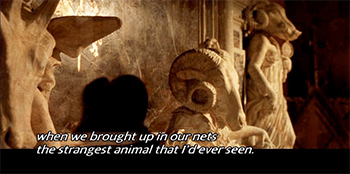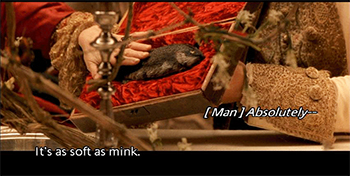by Wikipedia
Accessed: 4/26/22
... Raymond Schwab's La renaissance orientale and studies on the history of the Western encounter with Asian religions such as Henri de Lubac's La rencontre du bouddhisme et de l'Occident presented an utterly confusing mass of data arranged according to modern notions such as "Buddhism" or "Hinduism" and to modern geographical units such as "India" or "China."
A major reason for this confusion was the fact that the primary sources seem to come from a different world where such neat delimitations do not exist. They tend, for example, to distinguish between esoteric and exoteric "branches" of a pan-Asian religion or to connect the creeds of various countries of "the Indies" to some descendant of Noah....
One of the ideas repeated in countless European sources about Asian religions is the distinction between "outer" or "exoteric" and "inner" or "esoteric" forms. It was already used in early Christian literature, for example, by Eusebius of Caesarea and Lactantius, to characterize heathen creeds around the Mediterranean. But its roots lie in ancient Greek views of Egyptian religion where Egyptian priests are said to have encoded secret esoteric teachings in hieroglyphs while feeding the outer, exoteric bark of religion to the people. This idea gained renewed popularity in the Renaissance when texts attributed to Hermes Trismegistos ("hermetic texts") were translated into Latin and portrayed as vestiges of ancient Egyptian "esoteric" monotheism. In Europe, this inspired proponents of ancient theology (prisca theologia) like the seventeenth-century Jesuit Athanasius Kircher as well as many missionaries....
After the discovery of America and the opening of the sea route to India at the end of the fifteenth century, new challenges to biblical authority arose. It was difficult to establish a connection between hitherto unknown people and animals and Noah's ark.... Our case studies show different ways in which Europeans tried to rise to such challenges: missionaries who attempted to incorporate ancient Asian cultures and religions into Bible-based scenarios; others who tried to move the starting shot of biblical history backward to beat the Chinese annals...
As early as the mid-sixteenth century, Jesuit missionaries also linked this distinction between exoteric and esoteric doctrines with phases of the Buddha's life. In 1551 Japanese Buddhists informed the Jesuit brother Juan Fernandez, who spoke some Japanese, that the founder of their religion, Shaka, "also wrote books so that they would pray to him and be saved." But at the age of 49 years, so Fernandez reported, Shaka had suddenly changed his approach and confessed that "in the past he had been ignorant, which is why he wrote so much." Based on his own experience Shaka thereafter discouraged people from reading his old writings and advocated "meditation in order to learn about oneself and of one's end". In the first comprehensive report about Buddhist sects and doctrines that reached the West (the Sumario de los errores of 1556), certain Buddhist texts were thus associated with specific sects, and Shaka was said to have dismissed his earlier writings: "They said that many people followed him and that he had 80,000 disciples. And ultimately, after having spent 44 years writing these scriptures, he said that nothing of that was true and that all was fombem (Jap. hoben, expedient means]"
However, Matteo Ricci's 1615 description of the sect of "sciequia or omitofo" (Shakya/Amitabha) and the corresponding Japanese teaching of "sotoqui" (Jap. hotoke, that is, buddhas) shows no trace of such a fundamental distinction between expedient and true teaching and exhibits little familiarity with Buddhism's "multitude of books" that, according to Ricci, "were either brought from the West or (which is more likely) composed in the Kingdom of China itself" (Ricci 1615:122)....
But after Ricci's death in 1610 and the publication of his view of Chinese religions by Trigault (1615), Ricci's critic Joao RODRIGUES (1561-1633) applied the distinction between exoteric and esoteric teachings more broadly to all three major religions of China and linked it to the ancient use of symbols in the Middle East and Egypt (see also Chapter I).... For Rodrigues this common root was lodged in Mesopotamia and associated with Zoroaster and the evil habit of the elites to mislead the common people by hiding the true doctrine under a coat of symbols....
Rodrigues's ideas and scholarship burrowed their way into the minds of other missionaries. One of them was the Milanese Cristoforo BORRl (1583-1632) who lived in Saigon from 1610 to 1623. His report about Cochinchina, published in 1631, gave the distinction between the exoteric and esoteric teachings of Buddhism a fateful twist. He reported that Xaca had immediately after his enlightenment written books about the esoteric teaching:Therefore returning home, he wrote several books and large volumes on this subject, entitling them, "Of Nothing;" wherein he taught that the things of this world, by reason of the duration and measure of time, are nothing; for though they had existence, said he, yet they would be nothing, nothing at present, and nothing in time to come, for the present being but a moment, was the same as nothing.
He argued likewise about moral things, reducing everything to nothing. Then he gathered scholars, and the doctrine of nothing was spread all over the East. However, the Chinese were opposed to this doctrine and rejected it, whereupon Xaca "changed his mind, and retiring wrote several other great books, teaching that there was a real origin of all things, a lord of heaven, hell, immortality, and transmigration of souls from one body to another, better or worse, according to the merits or demerits of the person; though they do not forget to assign a son of heaven and hell for the souls of departed, expressing the whole metaphorically under the names of things corporeal, and of the joys and sufferings of this world". While the Chinese gladly received the "external," modified teaching of Xaca, the teaching of nothing also survived, for instance, in Japan in the dominant "gensiu" (Jap. Zen-sha, Zen sect). According to Borri, it was exactly this acceptance in Japan that had the Buddha explain on his deathbed that the doctrine of nothingness was his true teaching:The Japanese and others making so great account of this opinion of nothing, was the cause that when Xaca the author of it approached his death, calling together his disciples, he protested to them on the word of a dying man, that during the many years he had lived and studied, he had found nothing so true, nor any opinion so well grounded as was the sect of nothing; and though his second doctrine seemed to differ from it, yet they must look upon it as no contradiction or recantation, but rather a proof and confirmation of the first, though not in plain terms, yet by way of metaphors and parables, which might all be applied to the opinion of nothing, as would plainly appear by his books
Of course, Borri's tale lacks all historical perspective and has the Buddha make decisions based on events (the introduction of Buddhism to China and Japan) that happened many centuries later. But for people who have no idea of the history of this religion, its attribution of motives to the founder must have sounded believable, and Borri's book was one of the early works on East Asia that was widely read and translated. This story, in my opinion, forms the kernel of the Buddha's "deathbed confession" tale. Borri appears to have spun it on the basis of information from Japan, from Rodrigues, and possibly also Vietnamese informants, in order to make sense of the different teachings of this religion whose founder is Xaca = Buddha....
Instead of first teaching about emptiness and subsequently "accommodating" Chinese or Indian sensibilities in a manner that resembles the Jesuit mission strategy, the founder of Buddhism was exposed as a liar and fraud who never told anyone about his nihilism and for forty-nine years preached an "exterior" doctrine he did not believe in....It combined elements from Jesuit letters and reports from Japan (particularly those regarding the Zen sect), Valignano's catechism, Rodrigues's reports, and Borri's and de Rhodes's tales and molded them into an easily understood deathbed confession story that not only exposed the founder's profound character flaw but also furnished a simple classification scheme for variants of his religion....
Like Rodrigues and Borri, Kircher used this division as a tool to bring order into East Asia's idolatries....
Why, then, one might ask, does La Croze call the Malabar heathendom an "idolatry" with "false gods" and a "cult of idols"? Because he saw it as a degenerated form of religion, a form that at some point had replaced the ancient monotheism that probably came straight from Noah's ark to India. The vestiges of this ancient monotheism were found, according to La Croze, in the Vedam and the books of the Gnanigol. But how did this degeneration take place -- and why were the Gnanigol so critical of the Brahmans, the very guardians of the Veda? We have seen that Ziegenbalg, who also believed in an original monotheism and a subsequent degeneration, put the blame on the devil and the Brahmans. But La Croze, more ingenious and more interested in history, cooked up an elaborate scheme to explain it all. His scenario begins, like Ziegenbalg's, with an age of pure monotheism whose heirs are the Gnanigol. Instead of the devil, La Croze saw the reason for the decline of this pure original religion in two migrations that invaded India. The first was by the "Nation of Sammaneens" and the second by "the Brahmans who recognize that their cult in Malabar followed that of a certain people that they regard as heathen and that they call the Nation of the Sammaneens" (491).
***
Since questions related to the genesis and authorship of the Ezour-vedam will be discussed in Chapter 7, the focus is here on Voltaire's role in its rise to fame. Whatever the intentions of its authors were, it was Voltaire who almost single-handedly transformed some missionary jottings from the South Indian boondocks into the "world's oldest text," the Royal Library's "most precious document," and (as a well-earned bonus for the promoter) into the Old Testament of his deism! So far, there is no evidence of any influence of this text before Maudave and Voltaire. But soon after Maudave's manuscript got into Voltaire's hands, the Ezour-vedam's brilliant career began. For Voltaire it was, for a few years, a potent weapon to undermine biblical authority and to attack divine partiality for Judeo-Christianity. It was no Jesuit missionary but rather Voltaire, the missionary of deism, who trumpeted extraordinary claims into the world about the Ezour-vedam's authenticity, antiquity, and supreme value. Paulinus a Sancto Bartholomaeo saw this quite clearly when in 1791 he called the Ezourvedam "the notorious gift from the most learned prince of philosophers, Voltaire" -- a poisoned gift "that found its way into the Royal library in Paris, or rather which he pressed upon them to use it as the foundation for his own philosophical superstructure" (Rocher 1984:16). It was a calculated move on the Indian flank of Voltaire's war against "l'infame," and as we will see in the remainder of this book, it was rather successful in inciting European enthusiasm for India as the cradle of civilization and preparing the ground for "indomania."
***
The two opposing views of China's first emperor were emblematic of two completely different views of the past. I have earlier called them "inclusive" and "exclusive," but even the "inclusive" view was in a sense exclusive since it also hijacked other people's histories and religions and embedded them in a fundamentally biblical scenario. For example, Webb's journey of Noah to China left the entire basic framework of the Old Testament narrative with its creator God, paradise, the Fall, the patriarchs, the deluge, and other biblical events intact and turned the Chinese into descendants of Noah. A metaphor from the commercial realm may be more to the point. What Webb, Martini, the China figurists, and Ramsay attempted can be called a "friendly takeover" [???!!!] whereas the approach of Rodrigues, Kircher, and the victors of the Rites controversy would constitute a "hostile takeover." The "hostile takeover" group usually made the Chinese descend from Noah's problem child Ham -- the one who had mocked his drunken father -- and regarded China's ancient religion not as noachic monotheism but as an evil concoction reeking of polytheism, idolatry, and superstition of Egyptian or Chaldean ancestry. The Sorbonne accusers of Louis Daniel Le Comte's and Charles Le Gobien's writings were of this persuasion, and so were the exclusivists in Rome, China, and India who adamantly opposed the approach of Ricci, de Nobili, and Ur-traditionalists of all colors. This "hostile takeover" group won in the rites controversy, and its victory not only led to the prohibition of publications by "friendly takeover" promoters but also became a factor in the expulsion of missionaries from China and the eventual dissolution of the Jesuit order (see Chapter 7). Moreover, as is documented in this book, it exerted a profound influence on the growth of Orientalism. But so did the opposing faction.
The proponents of a "friendly takeover" put the Chinese and their first emperor into the transmission line tethered to Noah and his good son Shem and believed that they were soundly monotheistic and fundamentally good. The hazards of this sort of friendly takeover are shown in the tragic fate of Li Zubo, a Chinese Christian who was executed in 1665 for having asserted in a treatise that biblical teachings were carried to China by early descendants of Adam and Eve, that China's founding father Fuxi was one of them, that biblical teachings had for many ages reigned in China, and that the old Chinese classics showed vestigial evidence of such teachings (Mungello 1989:93). Li wrote,The first Chinese really descended from the men of Judea who had come to the East from the West, and the Teaching of Heaven is therefore what they recalled. When they produced and reared their children and grandchildren, they taught their households the traditions of the family, and this is the time when this teaching came to China. (trans. Rule 1986:99)
While Li's treatise pleased the "accommodationist" faction and his Jesuit mentors, who possibly had a hand in its redaction, it enraged seal-carrying shareholders of the Chinese empire like the official Yang Guangxian, who launched a formal accusation and succeeded in having the unfortunate Li Zubo executed. It seems that Chinese officials regarded this not exactly as a "friendly" takeover of their past....A friendly takeover is an acquisition which is approved by the management of the target company. Before a bidder makes an offer for another company, it usually first informs the company's board of directors. In an ideal world, if the board feels that accepting the offer serves the shareholders better than rejecting it, it recommends the offer be accepted by the shareholders.
-- Takeover, by Wikipedia
Joachim BOUVET(1656-1730) first explained his figurist system in a letter to Bignon (dated September 15, 1705) ... Bouvet brought an amazing text into play:One will be forced to admit that the canonical books of China are the most ancient works of natural law that can today be found among the heathens and even among the believers, not even excepting the Pentateuch of Moses; that is true at least for the book ye kim [Yijing] which can with assurance be regarded as the most ancient work known in the world. (p. 39)
The "veritable author" of this book is, according to Bouvet, the "holy Patriarch Enoch whose works, according to Tertullian, were rejected by the Jews because they talked too clearly of the Messiah and the incarnation of a God who would himself come to expiate the world" (p. 39). While the Chinese people thought that Fuxi was the Yijing's author and inventor of its hieroglyphs and ancient "mystical science" (p. 39), Bouvet was convinced that the Chinese had -- like many other peoples -- unknowingly adopted the antediluvian biblical patriarch Enoch as a founder figure:But we add and dare to affirm that this alleged founder of the Chinese monarchy is none other than he whom most ancient nations have recognized ... as the founder not only of their laws and customs but also of their religion, sciences, ancient books, writing systems, and languages. Consequently the Fo-hi [Fuxi] of the Chinese, the Hermes or Mercury Trismegist of the Egyptians and GReeks, the Thot of the Alexandrians, the Idris or Adris of the Arabs, and the Enoch of the Hebrews are one and the same person who is revered by diverse nations under different names. (p. 42)
In this manner Bouvet attempted a friendly takeover of the remote antiquity of the world's ancient nations, and the two reputedly oldest ones -- Egypt and China -- both got a biblical pedigree. This was more elegant than Huet's attempt to hijack entire dynasties of gentile divinities by identifying them all as disguised members of Moses's family, but it was nevertheless a takeover of global proportions.
***
... de Visdelou dictated a few pages about the religions of China to the visiting Mr. Basset in order to explain the background of a regional persecution of Christians. Basset's notes made their way to Paris and into the hands of Father Le Gobien who edited and used them as introduction to his book about the edict of tolerance issued by the Chinese emperor (1698), which was then used by Bayle and Diderot. Already the first few lines show the extent and character of Le Gobien's editorial interference. He was an inclusivist in the line of Matteo Ricci who shared the opinion of the vast majority of Jesuits that the ancient religion of China (and Confucianism as its successor) had venerated the true God. De Visdelou, by contrast, was one of the few dissenters in the line of Joao Rodrigues who thought that ancient Chinese religion and Confucianism were forms of atheism. Already the initial paragraphs of de Visdelou's report as taken down by Basset were heavily edited by Le Gobien and exhibit an immense difference of opinion. De Visdelou only discussed modern Confucianism, Buddhism, and Daoism and lost no word about an ancient Chinese monotheism. The latter was added by Le Gobien, who claimed that this ancient Confucianism was still extant with the Chinese emperor as head ...De Visdelou's dictation text (c. 1696).
I cannot dispense myself from providing a general idea of the different sects of China. Without this one would not understand the thinking of the Viceroy who compares them among themselves and with the Christian religion. It is sufficiently known that there are three principal ones of which the first is that of the philosopher scholars (I mean the modern philosophers, not the ancient ones). The second one is that of the brachmanes, and the third that of the bonzes.
The first is the dominant one [!!!] ... [etc.]...Le Gobien's published text (1698)
Since the history I write concerns only religion, I cannot dispense myself from providing to my reader a general idea of the different sects that are current in China. There are four principal ones.
The first is of those who, less by a feeling of piety than by respect for the ancients, recognize in the world a superior spirit, eternal, almighty, and much like the one known in the first centuries of the monarchy as the Lord of Heaven. It must be admitted that the number of these veritable worshippers is not very great, even though the Emperor is their head and has often declared that it was to God that he offered the sacrifices in the temples and not to those inferior and imaginary spirits with which the people is so ridiculously infatuated.
The second is the dominant one ... [etc.]...
But Le Gobien's confusion is understandable...
... Instead of simplifying things as he intended, Le Gobien added another layer of confusion.
-- The Birth of Orientalism, by Urs App
ROCHER COMPLETELY REFUTES URS APP'S ARGUMENT THAT "IT WAS VOLTAIRE WHO ALMOST SINGLE-HANDEDLY TRANSFORMED SOME MISSIONARY JOTTINGS FROM THE SOUTH INDIAN BOONDOCKS INTO 'THE WORLD'S OLDEST TEXT,'" BUT URS APP HIDES THIS FACT FROM US:
A New Manuscript: BN Fonds Francais 19117
In the meanwhile, no one seems to have noticed the existence, in the Bibliotheque Nationale, of a third manuscript of the EzV. The catalogue: Ancien Saint-Germain Francais III. Nos. 18677-20064 du Fonds Francais (by L Auvray and H. Omont, Paris: Leroux, 1900), has the following entry: "19117, 'Zozur Bedo'; traduction francaise du YADJOUR VEDA,4c livre des Vedas. En huit livres. XVIIe-XVIIIe. Papier. ) 58 pages. 208 sur 205 millimetres. Cartonne. (Saint-Germain, Harlay 515.)." This is, indeed, another copy of the EzV, in eight books.
The manuscripts of the Harlay family were donated, by Achille IV de Harlay (died 23 July 1717) to Louis-Germain de Chauvelin (1685-1762), on 11 August 1716. The condition attached to the donation said that the manuscripts should stay with de Chauvelin and his male descendants until one of them died without further male descendants "revetus de charge de judicature." [Google translate: load bearing judicature.] At that time the manuscripts were to become the property of the Benedictines of the abbey of Saint-Germain-des-Pres. Chauvelin not only allowed the members of the [Benedictine] Order to use the materials while he still held the usufruct; he also enriched the collection with documents which were his own full property. On 19 March 1755 he decided to transfer the collection to Saint-Germain, together with those manuscripts of which he himself was the owner. The manuscripts were transferred from the castle of Grosbois to the abbey. They remained a special fund while deposited there, until they were transferred, together with the other manuscripts of Saint-Germain, to the Bibliotheque Nationale, in 1865. There the entire collection was integrated into the "Troisieme Serie" of the Fonds Francais: manuscripts 15370 to 20064.
These data do not entirely solve the problem of the origin of the third EzV manuscript. The donation of 11 August 1716 was accompanied by a catalogue which is, however, lost, with the result that it is no longer possible to ascertain which particular manuscripts were added to the collection by de Chauvelin. We can only presume that the EzV did not belong to the original collection of 1716, and that it was one of the latest additions; it is no. 515 in a collection of altogether 519 items. But, even then, the third EzV manuscript must have belonged to the collection by 1755, five years before Maudave brought his copy to Europe.
The principal problem that remains unsolved in all this is that in two handwritten catalogues at the Bibliotheque Nationale, manuscript "Harlay 515" is described as "Melanges cont. 110. pieces": in the "Catalogue des manuscrits de Monsieur** [Chauvelin]",91 and in the "Catalogue des mss. de la bibliotheque de feu Mre Achilles de Harlay, premier president du Parlement de Paris, passes depuis dans la bibliotheque de feu messire Louis- Germain Chauvelin, ancien garde des sceaux, et actuellement dans la bibliotheque de l'abbaye de Saint-Germain-des-Pres, a Paris, 1762."92 [Google translate: Catalog of mss. of the library of the late Mre Achilles de Harlay, first Speaker of Parliament of Paris, since passed in the library of the late Messire Louis-Germain Chauvelin, former Keeper of the Seals, and currently in the library of the Abbey of Saint-Germain-des-Pres, in Paris, 1762.]
Even assuming that the EzV manuscript did belong to the private collection of Louis-Germain de Chauvelin on 19 March 1755, it is no longer possible to investigate how and when he acquired it. The important fact is that it is the oldest EzV manuscript in Europe, even though no one ever took notice of it. It also shows that the terminus ante quem [Google translate: term before he] for the composition of the EzV, which until now was 1759 -- the time when Maudave left India --, has to be advanced with at least five years and possibly by more than that.
-- Ezourvedam: A French Veda of the Eighteenth Century, Edited with an Introduction by Ludo Rocher
Apologetics (from Greek ἀπολογία, "speaking in defense") is the religious discipline of defending religious doctrines through systematic argumentation and discourse.[1][2][3] Early Christian writers (c. 120–220) who defended their beliefs against critics and recommended their faith to outsiders were called Christian apologists.[4] In 21st-century usage, apologetics is often identified with debates over religion and theology.
Etymology
The term apologetics derives from the Ancient Greek word apologia (ἀπολογία).[1] In the Classical Greek legal system, the prosecution delivered the kategoria (κατηγορία), the accusation or charge, and the defendant replied with an apologia, the defence.[5] The apologia was a formal speech or explanation to reply to and rebut the charges. A famous example is Socrates' Apologia defense, as chronicled in Plato's Apology.
In the Koine Greek of the New Testament, the Apostle Paul employs the term apologia in his trial speech to Festus and Agrippa when he says "I make my defense" in Acts 26:2.[6] A cognate form appears in Paul's Letter to the Philippians as he is "defending the gospel" in Philippians 1:7,[7] and in "giving an answer" in 1 Peter 3:15.[8]
Although the term apologetics has Western, primarily Christian origins and is most frequently associated with the defense of Christianity, the term is sometimes used referring to the defense of any religion in formal debate involving religion.
Apologetic positions
Baháʼí Faith
Main article: Baháʼí apologetics
Many apologetic books have been written in defence of the history or teachings of the Baháʼí Faith. The religion's founders wrote several books presenting proofs of their religion; among them are the Báb's Seven Proofs and Bahá'u'lláh's Kitáb-i-Íqán.[9] Later Baháʼí authors wrote prominent apologetic texts, such as Mírzá Abu'l-Fadl's The Brilliant Proof and Udo Schaefer et al.'s Making the Crooked Straight;.[10]
Buddhism
One of the earliest Buddhist apologetic texts is The Questions of King Milinda, which deals with the Buddhist metaphysics such as the "no-self" nature of the individual and characteristics such as of wisdom, perception, volition, feeling, consciousness and the soul. In the mid-19th century, encounters between Buddhists and Christians in Japan prompted the formation of a Buddhist Propagation Society.
Around 1863, newly arrived in Japan, Charles changed his surname to Pfoundes, learned Japanese and developed a passion for studying Japanese customs and culture. He subsequently made a career for himself as an East-West middleman, based mainly in Japan but with a thirteen-year period (1879-1892) in London where he gave innumerable talks on Japan and other topics and in 1889 founded the ‘Buddhist Propagation Society’; the first-ever Buddhist mission to the West (Bocking et al. 2014). As far as we know Charles never met, nor indeed wanted to contact, his brother Elam or his father James after he left them in Ireland in 1854. He did however spend time, though hardly quality time, with his mother on several occasions. In 1874 Caroline travelled to Tokyo, where Pfoundes held a responsible position in a major shipping company. That visit ended, according to Caroline’s later testimony in a Dublin courtroom in 1877, with Charles forcibly taking from her all the money she had brought with her to Japan, so that she was obliged to rely on the assistance of friends to get home. Caroline was in court because Charles, who in 1877 was travelling the world prior to settling, as he planned, in London, had visited Caroline in her own home in Dublin in May 1877 when she was in her early 60s and physically assaulted her when she did not give him back some Japanese ornaments he wanted. In October he returned and threatened to attack her again if she did not give him some papers. Pfoundes only avoided jail by paying sureties to keep the peace towards his mother for 12 months (‘A Strange Case’ 1877; ‘Extraordinary case’ 1877).
-- Mrs Pounds and Mrs Pfoundes: A Futuristic Historical Essay in Honour of Professor Ursula King [Charles James William Pounds Pfoundes] [Excerpt], by Brian Bocking
Up until recently it has been widely accepted that the British monk Ananda Metteyya’s (Allan Bennett) founded and organized the first Buddhist mission to the West in London in 1908. Recent collaborative research by historians in Japan and Ireland however has shown that this assumption needs to be revised. In fact it was not Theravadian but rather Japanese Mahayana Buddhists who were the first to try to teach Buddhism in the West. In 1889 the Japanese-sponsored Buddhist Propagation Society (BPS) of Japan launched a mission to London led for three years by the Irish-born Buddhist Captain Charles Pfoundes. The Buddhist Propagation Society had chosen a particularly opportune time to send its mission. Gilbert and Sullivan’s Japanese-themed opera The Mikado was running to record crowds in London and several exhibitions of Japanese art in London and Paris had created a fascination in things Japanese.
-- The hidden history of Buddhism in the West [Charles Pfoundes], by Bhante Dhammika of Australia
Early Buddhist missions to the West: the conventional history
In April 1908 the Rangoon-ordained Buddhist monk Ananda Metteyya (Allan Bennett, 1872-1923) arrived in London with a party of Burmese sponsors. Ananda Metteyya‘s very presence in the capital, as a yellow-robed, shaven-headed monk demonstrating by example that it was (just) possible for a European to follow the strict vinaya regime in Edwardian London, aroused a good deal of interest in the press and among the public. In addition to preaching by example, Ananda Metteyya -- not a gifted orator -- delivered some talks on Buddhist thought and practice and gave interviews to the press.1 Within six months he was en route back to Burma.2 This visit is commonly regarded as the epochal first Buddhist mission to Europe, and for many writers marks the 'real' beginning of Buddhism-as-a-lived-religion in the UK.3
While Ananda Metteyya‘s 1908 mission to London has long been identified as a starting-point for the story of 'Buddhism in Britain', students of Western Buddhism are by now well aware that it was not the first Buddhist mission to the West. Japanese Buddhist missions, oriented mainly towards expatriate Japanese but with active Western adherents, had developed in California from 1899 onwards4 and these West Coast missions are now considered by scholars to be the earliest Buddhist missions to the West (Tweed 2000).
In this article, we set out to demonstrate that the first London Buddhist mission was in fact established in 1889, predating even the Californian missions by a decade. From 1889 to 1892, the Irish-born Japanese Buddhist Charles J. W. Pfoundes (1840-1907) headed an official Buddhist mission known as the 'Buddhist Propagation Society'. This was based in Westminster, operated throughout London and its suburbs and was the first and indeed only foreign outpost of the Kaigai Senkyo Kai (lit. 'Overseas Propagation Society' but normally translated 'Buddhist Propagation Society'), an initiative of a group of reformist Jodo Shinshu (True Pure Land) Buddhists based in Kyoto.
The Buddhist Propagation Society in London and Pfoundes' role in it were of course known to, and publicised by, his Buddhist sponsors in Japan at the time5 and at least one contemporary Japanese account6 was available to Notto Thelle, who in 1987 wrote:The Society for Communication with Western Buddhists (Obei Bukkyo Tsushinkai) was founded in 1887; it was later reorganized as the Buddhist Propagation Society (Kaigai Senkyo Kai, literally Overseas Missionary Society), under the leadership of Akamatsu Renjo. Its purpose was to propagate Buddhism in the West, through missionaries and publications. A branch office was established in London in 1890, and a journal was published, entitled Bijou of Asia [Ajia no hōshu].
…[a]nother Western Buddhist, C. Pfoundes, also supported Japanese Buddhists against Christianity. He had first come to Japan in the 1860s as an officer in the British navy and remained for about twelve years, of which he reportedly spent seven or eight years in Buddhist temples. As an admirer of the ancient Japanese civilization and of Buddhism, he had dedicated much of his time to lecturing on Buddhism in the United States (1876-1878) and in England (1878-1893). He served as secretary of the London branch of the Buddhist Propagation Society and came to Japan again in 1893 at the invitation of his Buddhist friends. In his many meetings he appealed to the national sentiment and attacked Christian missionaries for slighting Buddhism and despising Japan as a barbarian country. Both Olcott and Pfoundes left Japan after controversies with their Japanese sponsors.
Thelle deserves credit for drawing attention to Pfoundes, who had remained unnoticed by other scholars, but Thelle had only limited information, some of which has been superseded by recent discoveries. For example, Pfoundes did not leave Japan after his return from London in early 1893 but remained there, resident and working in a variety of roles in the port city of Kobe where he died in 1907 and is buried in the foreigner‘s cemetery.7 Thelle portrays Pfoundes as little more than a transient foreigner, a pale version of the exotic Theosophical 'White Buddhist' Olcott, but in fact by 1890 Pfoundes had become a fierce opponent of Theosophy. Far from being a transient visitor like Olcott, Pfoundes spent a total of 26 years of his life in Japan and in 1899 even applied for Japanese nationality (Ruxton 2008, Bocking 2013). Ironically, it is because Pfoundes did not return to London but instead died alone in Kobe that his pioneering activities on behalf of Buddhism in the West were forgotten, while Ananda Metteyya‘s brief visit almost two decades later came to be remembered, through his later colleagues in London, as the 'first' Buddhist mission to the capital.
Beyond Thelle‘s brief depiction, Pfoundes' name has been remembered elsewhere but for a quite different reason. A collection of his newspaper columns on diverse aspects of Japanese art, folklore and customs was published by The Japan Herald in Yokohama in 1875 under the title Fuso mimi bukuro or A Budget of Japanese Notes. This work, similar to and subsequently overshadowed by Basil Hall Chamberlain's Things Japanese: Being Notes on Various Subjects Connected with Japan (1890), remains widely available and is still cited occasionally in modern scholarship, for example by Hendry (1981).
With the very recent advent of digital technologies which enable searches for lost fragments of information across thousands of local newspapers, popular magazines and archive collections, many new details of Pfoundes' remarkable life have now come to light.8 In 2013, Bocking offered a first brief biography, based on some of this new evidence (Bocking 2013). That article was however concerned mainly with Pfoundes' activities between his return to Japan from London in 1893 and his death in 1907. Of the putative 'London Buddhist Mission' Bocking could say at the time only that:[a]bout this time [the early 1890s] Pfoundes became the London representative of the modern Jodo Shinshu-backed Japanese Buddhist missionary society the Kaigai Senkyo Kai, in which role he reportedly warned the young scholar Takakusu Junjiro away from the London Theosophists and hence towards Max Muller (Akai 2009, 190); a significant Weberian moment in the history of Japanese Buddhology, if so. The other activities, if there were any, of Pfoundes' London Japanese Buddhist outpost remain undocumented; perhaps an unwritten - and very early - chapter in the history of Buddhism in the UK.
Further research since 2013 has generated a great deal of new material specifically on the BPS in London, and the present article attempts to write that 'unwritten‘ chapter, at least in outline9.
The role of Mr Okazaki Hideki, a researcher from Matsue who had become interested in Pfoundes' connections with that city, should be acknowledged here. Mr Okazaki first found (in Nakanishi, 1892) a reproduction of the decorative 2-sided leaflet in Japanese and English used by Pfoundes in London to advertise the 'Buddhist Propagation Society‘.10 With confirmation that the English name of Pfoundes' London organisation was simply the 'Buddhist Propagation Society‘ and with his name and address indicating that the BPS had more than a nominal presence in London, we began searching new sources and were able to unearth numerous fragmentary references to the BPS in newspapers and magazines of the time and to uncover the remarkable extent of Pfoundes‘ engagement in Buddhist missionary work in London.
-- The First Buddhist Mission to the West: Charles Pfoundes and the London Buddhist mission of 1889 – 1892, by Brian Bocking [Buddhist Propagation Society]
In recent times, A. L. De Silva, an Australian convert to Buddhism, has written a book, Beyond Belief, providing Buddhist apologetic responses and a critique of Christian Fundamentalist doctrine.[11] Gunapala Dharmasiri wrote an apologetic critique of the Christian concept of God from a Theravadan Buddhist perspective.[12]
Christianity
Main article: Christian apologetics
[x]
The Shield of the Trinity, a diagram frequently used by Christian apologists to explain the Trinity
Christian apologetics combines Christian theology, natural theology,[13] and philosophy to present a rational basis for the Christian faith, to defend the faith against objections and misrepresentation.
Christian apologetics has taken many forms over the centuries. In the Roman Empire, Christians were severely persecuted, and many charges were brought against them. J. David Cassel[14] gives several examples: Tacitus wrote that Nero fabricated charges that Christians started the burning of Rome.[15] Other charges included cannibalism (due to a literal interpretation of the Eucharist) and incest (due to early Christians' practice of addressing each other as "brother" and "sister"). Paul the Apostle, Justin Martyr, Irenaeus and others often defended Christianity against charges that were brought to justify persecution.[16]
Later apologists have focused on providing reasons to accept various aspects of Christian belief. Christian apologists of many traditions, in common with Jews, Muslims, and some others, argue for the existence of a unique and personal God. Theodicy is one important aspect of such arguments, and Alvin Plantinga's arguments have been highly influential in this area. Many prominent Christian apologists are scholarly philosophers or theologians, frequently with additional doctoral work in physics, cosmology, comparative religions, or other fields. Others take a more popular or pastoral approach. Some prominent modern apologists are Douglas Groothuis, Frederick Copleston, John Lennox, Walter R. Martin, Dinesh D'Souza, Douglas Wilson, Cornelius Van Til, Gordon Clark, Francis Schaeffer, Greg Bahnsen, Edward John Carnell, James White, R.C. Sproul, Hank Hanegraaff, Alister McGrath, Lee Strobel, Josh McDowell, Peter Kreeft, G. K. Chesterton, William Lane Craig, J. P. Moreland, Hugh Ross, David Bentley Hart, Gary Habermas, Norman Geisler, Scott Hahn and RC Kunst.[17]
Notable apologists within the Catholic Church include Bishop Robert Barron,[18] G. K. Chesterton,[19] Dr. Scott Hahn, Trent Horn, Jimmy Akin, Patrick Madrid, Kenneth Hensley,[20] Karl Keating, Ronald Knox and Peter Kreeft.
John Henry Newman (February 21, 1801 – August 11, 1890) was an English convert to Roman Catholicism, later made a cardinal, and beatified in 2010. In early life he was a major figure in the Oxford Movement to bring the Church of England back to its Catholic roots. Eventually his studies in history persuaded him to become a Roman Catholic. When John Henry Newman entitled his spiritual autobiography Apologia Pro Vita Sua in 1864, he was playing upon both this connotation, and the more commonly understood meaning of an expression of contrition or regret.
Christian apologists employ a variety of philosophical and formal approaches, including ontological, cosmological, and teleological arguments.[21] The Christian presuppositionalist approach to apologetics utilizes the transcendental argument for the existence of God.[22]
Tertullian was a notable early Christian apologist. He was born, lived and died in Carthage. He is sometimes known as the "Father of the Latin Church". He introduced the term Trinity (Latin trinitas) to the Christian vocabulary[23] and also probably[citation needed] the formula "three Persons, one Substance" as the Latin "tres Personae, una Substantia" (itself from the Koine Greek "treis Hypostaseis, Homoousios"), and also the terms Vetus Testamentum (Old Testament) and Novum Testamentum (New Testament).
Latter-day Saints
Further information: Mormon studies § Apologetics
There are notable Latter-day Saint apologists who focus on the defense of Mormonism, including early church leaders such as Parley P. Pratt, John Taylor, B. H. Roberts, James E. Talmage and more modern figures such as Hugh Nibley, Daniel C. Peterson, John L. Sorenson, John Gee, Orson Scott Card, and Jeff Lindsay.
Several well-known apologetic organizations of the Church Of Jesus Christ of Latter-Day Saints, such as the Foundation for Ancient Research and Mormon Studies (a group of scholars at Brigham Young University) and FairMormon (an independent, not-for-profit group run by Latter Day Saints), have been formed to defend the doctrines and history of the Latter Day Saint movement in general and The Church of Jesus Christ of Latter-day Saints in particular.
Deism
Deism is a form of theism in which God created the universe and established rationally comprehensible moral and natural laws but no longer intervenes in human affairs. Deism is a natural religion where belief in God is based on application of reason and evidence observed in the designs and laws found in nature.[12] The World Order of Deists maintains a web site presenting deist apologetics that demonstrate the existence of God based on evidence and reason, absent divine revelation.
Hinduism
Hindu apologetics began developing during the British colonial period. A number of Indian intellectuals had become critical of the British tendency to devalue the Hindu religious tradition. As a result, these Indian intellectuals, as well as a handful of British Indologists, were galvanized to examine the roots of the religion as well as to study its vast arcana and corpus in an analytical fashion. This endeavor drove the deciphering and preservation of Sanskrit. Many translations of Hindu texts were produced which made them accessible to a broader reading audience.
A range of Indian philosophers, including Swami Vivekananda and Aurobindo Ghose, have written rational explanations regarding the values of the Hindu religious tradition. More modern proponents such as the Maharishi Mahesh Yogi have also tried to correlate recent developments from quantum physics and consciousness research with Hindu concepts. The late Reverend Pandurang Shastri Athavale has given a plethora of discourses regarding the symbolism and rational basis for many principles in the Vedic tradition. In his book The Cradle of Civilization, David Frawley, an American who has embraced the Vedic tradition, has characterized the ancient texts of the Hindu heritage as being like "pyramids of the spirit".
Islam
'Ilm al-Kalām, literally "science of discourse",[24] usually foreshortened to kalam and sometimes called Islamic scholastic theology, is an Islamic undertaking born out of the need to establish and defend the tenets of Islamic faith against skeptics and detractors.[25] A scholar of kalam is referred to as a mutakallim (plural mutakallimūn) as distinguished from philosophers, jurists, and scientists.[26]
Judaism
See also: Jewish polemics and apologetics in the Middle Ages
Jewish apologetic literature can be traced back as far as Aristobulus of Paneas, though some discern it in the works of Demetrius the chronographer (3rd century BCE) traces of the style of "questions" and "solutions" typical of the genre. Aristobulus was a Jewish philosopher of Alexandria and the author of an apologetic work addressed to Ptolemy VI Philometor. Josephus's Contra Apion is a wide-ranging defense of Judaism against many charges laid against Judaism at that time, as too are some of the works of Philo of Alexandria.[27][28]
In response to modern Christian missionaries, and congregations that "are designed to appear Jewish, but are actually fundamentalist Christian churches, which use traditional Jewish symbols to lure the most vulnerable of our Jewish people into their ranks",[29] Jews for Judaism is the largest counter-missionary organization in existence, today. Kiruv Organization (Mizrachi), founded by Rabbi Yosef Mizrachi, and Outreach Judaism, founded by Rabbi Tovia Singer, are other prominent international organizations that respond "directly to the issues raised by missionaries and cults, by exploring Judaism in contradistinction to fundamentalist Christianity."[30][31]
Pantheism
Some pantheists have formed organizations such as the World Pantheist Movement and the Universal Pantheist Society to promote and defend the belief in pantheism.[32]
Native Americans
In a famous speech called "Red Jacket on Religion for the White Man and the Red" in 1805, Seneca chief Red Jacket gave an apologetic for Native American religion.[33]
In literature
Plato's Apology may be read as both a religious and literary apology; however, more specifically literary examples may be found in the prefaces and dedications, which proceed many Early Modern plays, novels, and poems. Eighteenth century authors such as Colley Cibber, Frances Burney, and William Congreve, to name but a few, prefaced the majority of their poetic work with such apologies. In addition to the desire to defend their work, the apologetic preface often suggests the author's attempt to humble his- or herself before the audience.[34]
See also
• Christian apologetics
• Dawah
• Existence of God
• Kalam
• List of apologetic works
References
1. "ἀπολογία". Blue Letter Bible-Lexicon. Retrieved 19 September 2016.
2. "Apologetics". The Advent. Retrieved 24 September 2016.
3. "apologetics". Merriam-Webster Dictionary. Retrieved 5 October 2016.
4. Cross, F. L., ed. (2005). "Apologists". The Oxford Dictionary of the Christian Church. New York: Oxford University Press.
5. Henry George Liddell, Robert Scott, A Greek-English Lexicon, κατηγορία and ἀπολογία[permanent dead link]
6. "Acts 26:2". Blue Letter Bible. 19 September 2016.
7. "Phl 1:7". Blue Letter Bible. 19 September 2016.
8. "1Pe 3:15". Blue Letter Bible. 19 September 2016.
9. Smith, Peter (2000). "apologetics". A concise encyclopedia of the Bahá'í Faith. Oxford: Oneworld Publications. pp. 39–40. ISBN 1-85168-184-1.
10. "Making the Crooked Straight, by Udo Schaefer, Nicola Towfigh, and Ulrich Gollmer". bahai-library.com.
11. De Silva, A. L. (1994). Beyond Belief, a Buddhist Critique of Fundamentalist Christianity (PDF). Three Gems Publications, ebook link at Buddha Dharma Education Association Incorporated, also. ISBN 978-0-6462-1211-1.
12. Dharmasiri, Gunapala (1974). A Buddhist critique of the Christian concept of God : a critique of the concept of God in contemporary Christian theology and philosophy of religion from the point of view of early Buddhism. Colombo : Lake House Investments – via WorldCat.
13. Brent, James. "Natural Theology". Internet Encyclopedia of Philosophy. Retrieved 10 March 2015.
14. J. David Cassel. "Defending the Cannibals: How Christians responded to the sometimes strange accusations of their critics." "Defending the Cannibals". Archived from the original on 2011-08-21. Retrieved 2012-09-08.
15. Tacitus, Annals XV.44
16. "Why Early Christians Were Despised". Christianity Today (Church history timeline). Retrieved 21 September 2016.
17. Catholic Education Resource Center: The Scott Hahn Conversion Story Archived July 18, 2012, at the Wayback Machine
18. "Page Not Found - Word On Fire". Archived from the original on 2015-02-08. Retrieved 2015-02-09. {{cite web}}: Cite uses generic title (help)
19. Chesterton, G K (2008). The Everlasting Man. Radford: Wilder Publications. p. 180. ISBN 978-1604592467.
20. "Kenneth Hensley - Catholic Apologetics Academy".
21. Coulter, Paul (2011-05-10). "An Introduction to Christian Apologetics". Bethinking. Retrieved 21 September 2016.
22. Apologetics: A Justification of Christian Belief John Frame-Joseph Torres - P&R Publishing - 2015 p. 67f
23. A History of Christian Thought, Paul Tillich, Touchstone Books, 1972. ISBN 0-671-21426-8 (p. 43)
24. Winter, Tim J. "Introduction." Introduction. The Cambridge Companion to Classical Islamic Theology. Cambridge: Cambridge UP, 2008. 4–5. Print.
25. Madeleine Pelner Cosman, Linda Gale Jones, Handbook to Life in the Medieval World, p 391. ISBN 1438109075
26. Clinton Bennett, The Bloomsbury Companion to Islamic Studies, p 119. ISBN 1441127887.
27. John Granger Cook (2000) The Interpretation of the New Testament in Greco-Roman paganism p.4., Mohr Siebeck Verlag, Tuebingen, Germany
28. "APOLOGISTS". Jewish Encyclopedia. 1906.
29. Simon Schoon, "Noachides and Converts to Judaism", in Jan N. Bremmer, Wout Jac. van Bekkum, Arie L. Molendijk. Cultures of Conversions, Peeters Publishers, 2006, ISBN 978-90-429-1753-8, p. 125.
30. About Us, Outreach Judaism website. Accessed January 9, 2011.
31. J. Gordon Melton, "The Modern Anti-Cult Movement in Historical Perspective", in Jeffrey Kaplan, Heléne Lööw. The Cultic Milieu: Oppositional Subcultures in an Age of Globalization, Rowman Altamira, 2002, ISBN 978-0-7591-0204-0, p. 285, note 4.
32. "The Pantheist Credo". World Pantheist Movement.
33. "Red Jacket on the Religion of the White Man and the Red by Red Jacket. America: I. (1761-1837). Vol. VIII. Bryan, William Jennings, ed. 1906. The World's Famous Orations". bartleby.com.
34. "Apology". Britannica Academic Edition. Encyclopædia Britannica. Retrieved 14 July 2011.
External links
• Religion portal
• Media related to Apologetics at Wikimedia Commons














